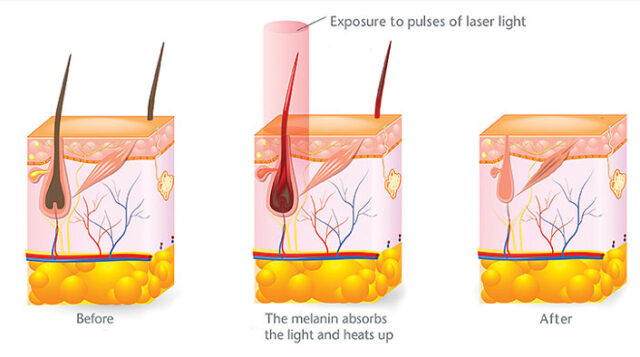Understanding Photothermolysis: The Science Behind Laser
At Albany Cosmetic and Laser Centre, we utilize advanced laser hair removal technology that relies on the principle of Selective Photothermolysis. This scientific process is what makes laser hair removal so effective at targeting unwanted hair while minimizing damage to surrounding tissues.
This page will help you understand how photothermolysis works, making your hair removal experience smoother and more efficient. Whether you’re curious about how the technology functions or why multiple sessions are necessary, we’ve got you covered!
What Is Photothermolysis?

Photothermolysis is a process where specific wavelengths of light are absorbed by targeted tissues** and converted into heat. When applied to laser hair removal, the target is melanin, the pigment that gives hair its color. By delivering precise laser pulses, the melanin absorbs the light energy, which then transforms into heat, effectively damaging the hair follicle.
The goal is to disrupt the follicle’s ability to produce new hair without affecting the surrounding skin. Because hair grows in cycles, multiple sessions are required to target follicles effectively during their Anagen (growth) phase when they are most vulnerable to laser energy.
How Photothermolysis Works In Laser Hair Removal
Laser hair removal using photothermolysis follows a straightforward yet sophisticated process:
- Energy Emission: The laser device emits light at a wavelength specifically chosen to be absorbed by melanin.
- Heat Generation: When the melanin absorbs the light, it converts it to heat, damaging the follicle.
- Follicle Disruption: The heat effectively disables the follicle’s ability to regrow hair.
- Safe Precision: Advanced cooling systems ensure skin safety and comfort during the procedure.
Why Multiple Sessions Are Necessary
Hair grows in three stages: **Anagen (growth), Catagen (transitional), and Telogen (resting)**. The laser is most effective during the Anagen phase when the hair is actively growing and connected to the follicle. Since not all hairs are in this phase simultaneously, several sessions are necessary to treat the majority of hair follicles effectively.
How Photothermolysis Enhances Safety and Effectiveness
Thanks to modern laser technology, **photothermolysis offers a precise and efficient solution** for hair reduction. The laser wavelength and pulse duration can be adjusted according to your skin type and hair color, ensuring maximum results with minimal discomfort. Cooling systems are also integrated to enhance comfort and protect the skin.
Frequently Asked Questions About Photothermolysis
What Makes Photothermolysis Effective For Hair Removal?
The process effectively targets melanin within hair follicles, converting light energy into heat that damages the follicle, preventing regrowth.
Is Photothermolysis Safe For All Skin Types?
Modern lasers can be adjusted to suit different skin tones. However, it’s essential to consult with a professional to determine the best approach for your skin type.
Why Are Multiple Treatments Necessary?
Laser hair removal works best during the Anagen (growth) phase of hair growth. Since not all hair follicles are in this phase at the same time, multiple sessions are required for effective results.
Can Photothermolysis Cause Skin Damage?
When performed by trained professionals, photothermolysis is safe and precise. Cooling systems are used to protect the skin during treatment.
What Should I Expect After A Session?
Mild redness or swelling may occur but typically resolves within hours. Following post-treatment guidelines ensures optimal results and comfort.
How Do I Know If Laser Hair Removal Is Right For Me?
A consultation at Albany Cosmetic and Laser Centre will help you understand if this treatment is suitable for your hair type, skin type, and desired outcomes.
